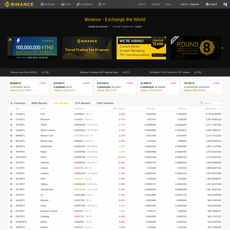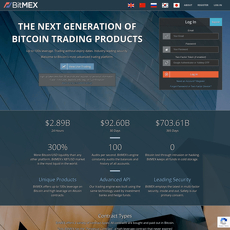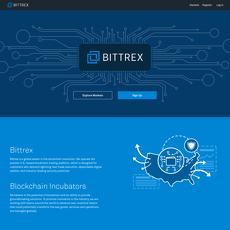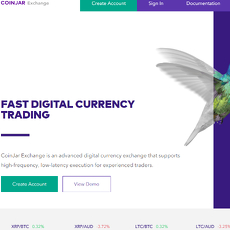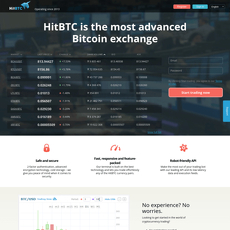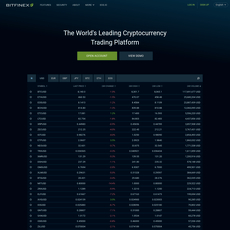Poloniex Review
Poloniex
poloniex.com
Poloniex Review 2025 — Is It Still Worth Your Crypto-Time? (Complete Guide & FAQ)
Thinking about using Poloniex but not sure if it’s still the solid crypto exchange it once was? You're not alone. With an overwhelming amount of crypto exchanges nowadays, we all feel that uncomfortable uncertainty — am I choosing correctly, is my crypto secure here, could I get lower fees elsewhere? Poloniex was one of those OG exchanges that dominated crypto trading early on, but faced its fair share of setbacks and controversies over the years. So the big question is: can you still confidently trust Poloniex with your crypto in 2025?
Why Choosing The Right Exchange Matters
Let's be real: choosing a cryptocurrency exchange is a lot more important than many of us initially thought. Sure, it feels great to jump into a trade quickly, but if withdrawals become a nightmare, or you can't rely on the platform's security, the excitement quickly evaporates.
Ever found yourself in this situation: you find the perfect crypto opportunity, make a profitable trade, only to face delays or multiple verification hoops just to use your own money? Not cool. Selecting the right place to trade crypto is just as crucial as picking the right crypto to invest in—after all, these exchanges handle your money.
- Security Matters — Hacks and breaches are unfortunately common. Having a secure platform isn't a luxury; it's a bare necessity. Losing money because of poor security measures would certainly sting.
- User-friendliness Counts — You don't want trouble doing simple tasks like depositing, withdrawing, or making trades. A good exchange removes complexity, it doesn't create additional hurdles.
- Fair Fees & Costs — Hidden fees mean unexpected drains on your profits. Transparency about fees lets you calculate profitability without nasty surprises.
My Goal: Give You the Full Picture
I know how frustrating it can be to hunt for clear reviews about exchanges. Sure, plenty out there give you biased perspectives filled with hype or criticism, but my priority is giving you an honest, transparent breakdown. We're talking clear info on fees, features, security, customer support, and everything else important.
Instead of generic statements or empty promises, I'll break down the Poloniex experience from every angle imaginable. I’ll answer those burning questions directly and openly—so at the end, you're not just guessing, you're making an informed decision about your trading future.
What You Can Expect in This Poloniex Guide
- A straightforward look at Poloniex’s core features—no fluff, just facts.
- An open assessment about the platform's security, reliability metrics, and potential red flags you need to know.
- The real pros and cons from my personal hands-on experience, backed by extensive research and real user feedback.
- Practical answers to actual questions regular crypto traders like you are asking.
Ready to truly understand whether Poloniex ticks all the right boxes as a crypto platform in 2025? Up next, we'll explore precisely what Poloniex offers today—including user-experience, supported coins, and all the essential features you'll want to hear about. Curious if Poloniex stacks up against popular competitors today? Keep reading—I promise I’ll make it worth your while.
Poloniex Comprehensive Overview (Features & User Experience)
Alright, we've heard a lot of chatter about Poloniex lately. Yeah, once upon a time it was a leading crypto exchange, but how does it hold up today in 2025? Let's cut through the clutter and see exactly what's on offer: coins, tools, user experience—everything you really want to know if you're considering trading your crypto here. I'll give you my genuine impressions, here and now, no fluff.
What Does Poloniex Offer Users Today?
Poloniex currently presents a pretty competitive lineup of trading features and services—enough to make it worthwhile to check out again:
- Crypto Coins & Trading Pairs: Poloniex boasts over 350 cryptocurrency pairs, including mainstays like Bitcoin (BTC), Ethereum (ETH), Litecoin (LTC), Solana (SOL), Dogecoin (DOGE), and a ton of altcoins. If you're an altcoin-chaser hunting the latest gem (or betting big on lesser-known projects), Poloniex does offer valuable options here.
- Margin & Leverage Trading: For more experienced traders who want to multiply their potential wins (but careful—also potential losses!), Poloniex provides margin trading options with leverage up to 5X.
- Crypto Lending: Got crypto sitting idle? Poloniex offers lending services, allowing you to earn passive interest by lending assets like BTC or USDT to other traders.
- Spot & Futures Markets: Poloniex makes trading straightforward, featuring both spot and derivatives markets, catering nicely for beginners and experienced traders alike.
Overall, Poloniex still has enough features on the table to pique anyone's interest—especially given their history in this space. But features alone aren’t enough, right?
"Design is not just what it looks like and feels like. Design is how it works." — Steve Jobs
How User-Friendly is Poloniex Really?
Here's the thing: even the strongest feature set won't keep traders happy unless it's wrapped in a smooth, intuitive interface. Thankfully, Poloniex has really upped their user experience game in recent years.
- Web Interface: Clean, modern, and pretty intuitive. Compared to their older interface—which, let’s be honest, was chaotic—the current version “gets it right.”. Charts from TradingView, clear market orders info, simple placements and executions—it just flows naturally.
- Mobile App: Poloniex has mobile apps for Android and iOS that largely mirror its desktop experience. The app interface is sleek, responsive, and refreshingly easy to navigate. Gone are the old days where app crashes frustrated users (trust me, I was one of them!). Recent updates seem to have greatly improved stability—finally.
- User Feedback: Most complaints I’ve researched lately tend to relate less to UX and more to support or security concerns (more on those later). The usability ratings from current traders are generally positive, signaling Poloniex succeeded in addressing many historical pain points—props to them.
My Quick Thoughts about Usability
Here's the straight-up truth from my own experience testing (and trading on) Poloniex:
- What I like: Honestly, it's refreshing. Trade executions felt snappy, navigating between markets was painless, and newer traders (or people coming back after a break) could easily find what they want without getting lost.
- What's annoying: The occasional slowdowns during big “market moments” (like sharp price spikes) still happen. They haven't totally fixed it, but it's significantly better (and honestly, lots of exchanges struggle during volatility spikes).
- Biggest Improvements: Interface design and mobile experience—compared to a few years back they've truly turned things around.
Overall, the usability is pretty solid—but usability itself is just one piece of the puzzle. No one loves surprise costs, right? Here's something every trader secretly wonders: how reasonable, or unfair, are Poloniex’s fees compared to the competition? That's exactly what we're checking next. Think Poloniex charges are truly fair? Let's keep going and find that answer together.
Fees, Costs & Limits — Are Poloniex Charges Fair?
Okay, let's tackle the uncomfortable topic head-on: fees. Yes, those tiny but frustrating charges can eat up a meaningful chunk of your hard-earned profits. So, does Poloniex play fair when it comes to how much they skim off your crypto activities? Or are they secretly draining your gains bit by bit?
Trading Fees Simplified
Poloniex uses a very typical maker-taker fee model—no surprises there. If you're not entirely sure what that means, don't worry, it's easier than it sounds:
- Makers: traders who add liquidity to the order book by placing trades that don't immediately fill existing orders.
- Takers: traders who instantly fill existing orders from the order book.
Poloniex trading fees start at 0.145% for takers and as low as 0.0% for makers (yes, you read that right—in some tiers, makers pay no fee at all). These fees get lower the more you trade, rewarding active users. It’s actually pretty competitive when compared to Coinbase (up to 0.60% maker/taker fees) or Kraken (around 0.26% taker fees).
"In trading, every penny saved on fees is another penny gained in profits—small savings add up profoundly over time."
Poloniex also offers discounted fees for holders of their TRX token and those who trade in large volumes. But of course, discounts sound appealing on paper—let’s find out if they’re really meaningful in practice.
Withdrawal & Deposit Fees
Here's where Poloniex shines a bit brighter. Depositing cryptocurrencies into your Poloniex account typically won't cost you a dime—nice.
However, withdrawing different cryptos involves varying fees. For example:
- Bitcoin (BTC) withdrawals carry a fixed fee of around 0.0005 BTC, slightly better than the industry average (some places charge significantly higher).
- Ethereum (ETH) withdrawal fees are about 0.01 ETH—moderate but can still add up with larger trading volumes.
- Stablecoins such as USDT (TRC20) and USDC typically incur very low withdrawal fees, generally around $1 or even less.
All withdrawal fees reflect network transaction costs, meaning fees vary depending on blockchain congestion. This transparency is something you’ll appreciate if fees keep you awake at night (been there!).
Limits And Restrictions Without KYC
And now, onto a hot topic—withdrawal limits without completing the Know-Your-Customer (KYC) process. Poloniex allows anonymous users to withdraw up to $10,000 worth of crypto per day without going through the hassle of uploading IDs or submitting personal info. This is especially appealing if you prefer keeping your crypto activities private or simply hate dealing with extensive paperwork.
But remember, with crypto regulations tightening globally, who knows how long such generous anonymous withdrawal limits might last? It's nice now, but is it safe and reliable into the future? Speaking of safety, there's something essential you’ll definitely want to read next:
How safe is your crypto really when using Poloniex? And do they safeguard your assets enough for you to sleep peacefully at night? Let’s find out…
Security & Trustworthiness: Can You Feel Safe Using Poloniex?
No crypto trader ever wants to face that sinking feeling of logging into an exchange to discover security has been compromised—believe me, I've felt that anxiety firsthand. When your money's online, security isn't just a nice-to-have; it’s absolutely essential.
Has Poloniex ever been compromised?
Let's be real, history matters. Back in 2014, Poloniex indeed faced a significant security breach; hackers made away with around 12% of the exchange’s bitcoin holdings at the time (that's about 97 Bitcoins). To Poloniex’s credit, they were transparent and promptly reimbursed affected users from their own reserves. Transparency and accountability in a crisis speaks volumes—especially when your own crypto is involved.
However, that incident left a lingering question mark: Is Poloniex truly trustworthy long-term?
What's Poloniex doing right now to keep your money safe?
Having gone through tough times themselves, Poloniex stepped up their security game significantly. Here's how they're currently safeguarding your assets:
- Cold Storage— The majority of user funds are stored offline in secure cold wallets. These can't be hacked remotely, dramatically reducing risk. Studies show exchanges using cold storage statistically face fewer breaches compared to completely hot wallet-based platforms. Good move there, Poloniex.
- Strong 2-Factor Authentication (2FA) — Mandatory two-factor authentication ensures you're the only person entering your account, even if someone else tries accessing your password. Multiple studies (including a recent Google research paper) show 2FA drastically cuts account hacking risks.
- Advanced Session Security — Poloniex employs IP-based monitoring and email notifications upon login from new devices. Brigading against phishing scams is always welcome.
- DDOS Protection and DNSSEC — Robust infrastructure enhancements help prevent distributed denial-of-service attacks, keeping your trading smooth and steady.
Additionally, Poloniex tries aligning their operations with international regulatory practices. They voluntarily impose restrictions and guidelines aligned with anti-money laundering (AML) measures, even though they're struggling navigating some tougher jurisdictions.
"Security is not a product, but a process."
I resonate strongly with this quote because it perfectly highlights that security is an ever-ongoing battle—no exchange should rest on historical setups.
Truthfully, Poloniex has learned from past mistakes and put solid policies in place since the hack. But here's a critical thought: are security measures alone enough reassurance for trading comfortably today? And more importantly, what about recent developments—should they worry or comfort you? Let's look closer at what recent Poloniex news reveals—can you afford to ignore what's really happening behind the scenes? Stick around, because we'll check this closer next!
Recent Poloniex News & Developments: What's Going On?
When it comes to cryptocurrency exchanges, constant change is the only constant. Poloniex is no exception. So, what's the latest scoop on Poloniex, and how does it affect you as a trader today?
Why Did Poloniex Shut Down in the US?
"Every change brings opportunities. It's up to us to adapt and thrive." – Anonymous Crypto Trader
You might have already heard that Poloniex discontinued its operations for US customers not too long ago. But why exactly did this happen? It all revolves around complicated regulatory dynamics and changes in ownership.
- Back in 2018, Circle, backed by Goldman Sachs, decided to acquire Poloniex with ambitious plans to expand it dramatically, targeting regulated cryptocurrency trading within the USA.
- However, things didn’t go as planned. Regulatory pressure mounted significantly, with the U.S. SEC (Securities and Exchange Commission) scrutinizing crypto trading practices and compliance more rigorously. This increased oversight led Circle to rethink their U.S. strategy.
- Eventually, in late 2019, Circle spun off Poloniex, resulting in closure for US-based traders due to regulatory restrictions. Since then, Poloniex has shifted focus entirely toward the international market, leaving its American customers behind and sparking significant frustration within the community.
What It Means For You
So, you're probably wondering: should this shake your confidence in Poloniex?
The short answer: It depends. If you’re based outside the US, Poloniex remains fully operational, offering numerous features and crypto pairs without obvious restrictions. Regarding trust, it's understandable to question a platform that has had such a high-profile pivot—especially one forced by regulations. However, it’s also worth considering that Poloniex's decision was likely crucial to maintaining operations in more crypto-friendly jurisdictions.
My suggestion is simple: Look carefully at your trading or investment goals. Are you in a country with tough regulations similar to the US? Are you comfortable using an exchange that actively adjusted its strategy in response to governmental pressures? Remember, awareness of these developments puts you ahead of the curve—and being informed means you have a significant advantage in crypto markets.
Curious how Poloniex really stacks up against other big-name exchanges after all this turmoil? Keep reading to see how it measures next to giants like Binance, Kraken, and Coinbase. You might just be surprised!
Comparing Poloniex: How It Stands Against Other Crypto Exchanges
Let’s be real—you and I both know the crypto market is flooded with exchanges fighting for your attention. Picking the right platform feels like entering a candy store; they all look good, but picking the wrong one leaves a bad taste. So, let's compare Poloniex with some heavyweight contenders like Binance, Kraken, and Coinbase. After all, isn't choosing the best place to trade just as important as picking the right coin to invest in?
What Makes Poloniex Unique?
Poloniex has features you won’t find everywhere. One standout is their crypto-lending market. Not a lot of exchanges offer such a straightforward way to lend your holdings and earn passive income. You simply lend your crypto directly on the platform, set rates yourself, and Poloniex finds borrowers automatically—pretty handy, right?
Another nice touch: their non-KYC policy. While Binance and Coinbase practically demand your shoe size along with your details (kidding, but you get the point!), Poloniex lets you withdraw up to $10,000 daily without KYC verification. This appeals to traders keen on fast, privacy-conscious trading.
"The quieter you become, the more you are able to hear." — Rumi
Now, why a quote from Rumi? Well, sometimes the quieter exchanges, those overlooked in the crypto frenzy—exchanges like Poloniex—can offer hidden perks if you really listen closely. It's about knowing exactly what you need, keeping your eyes and ears wide open.
Should You Consider Another Exchange?
I’m all for options. If you've traded long enough like me, you’ll notice that even the best exchanges have their quirks and drawbacks. Let's briefly compare Poloniex to other popular names to give you clear choices:
- Coinbase: Excellent reputation, highly regulated, ultra user-friendly—but trade fees can sting (typically higher than Poloniex). Coinbase is my go-to recommendation when newbies ask, "What's the easiest exchange to start crypto trading?"
- Binance / Binance.US: Crazy amount of coins, low fees, endless features. Binance's strength lies in flexibility, powerful advanced trading options, crypto staking, and a great P2P market. However, strict KYC and regulatory hurdles recently caused headaches for US traders who transitioned to Binance.US.
- Kraken: Known for fantastic security and reliable customer service—two critical factors we all value when our money is involved. Kraken particularly excels if you appreciate security over everything else. They’ve reportedly never faced any serious hacks, making it a solid recommendation for the question—I hear a lot from friends—"What exchange is the most secure?"
If reputation and strict regulation matter most to you, Coinbase or Kraken might feel safer. If you're looking for endless crypto variety or trading flexibility, Binance crushes it. Yet Poloniex seems to strike a balance between lower fees, flexibility, privacy, and unique lending options—certainly worth considering depending on your priorities.
Here's the thing though—I know exchanges aren’t banks. Ever struggled cashing out your crypto smoothly, quickly, and without losing half your money in fees?
You might be asking: "How easy is it actually to deposit crypto into Poloniex and then cash out smoothly?" You’re about to find out exactly how seamless—or tricky—it might be, so stick around. That next part might just save you some headaches (and money).
Deposits, Withdrawals & Cashing Out Guide: How Easy Is It with Poloniex?
Let's face it, nothing hits harder than the frustration you feel when trying to cash out your crypto and encountering hidden hassles or slow processing. Trust me—I've been there, anxiously waiting and refreshing the page a thousand times! Poloniex says they're hassle-free, but let's see what reality actually looks like when it comes to moving your crypto in or out.
Easy Steps to Deposit Crypto into Your Poloniex Account
If you're new or just don't want added complexity, I’ve broken this down into simple, digestible steps:
- Step 1: Log into your Poloniex account and click the "Wallet" button at the top of your screen.
- Step 2: Select "Deposit" next to the crypto you wish to transfer. For example, if you're depositing Ethereum, pick ETH from the crypto list provided.
- Step 3: Poloniex will generate a unique deposit address—copy it carefully and send crypto from your external wallet or another exchange. (Double-check the address, always!)
- Step 4: Wait for confirmations—it typically takes a few minutes to a half-hour, depending on network traffic.
(Quick note: Poloniex doesn't support direct fiat deposits like USD or EUR. You'll need crypto or stablecoins like USDT. I personally use stablecoins for smooth flexibility.)
How To Withdraw Your Crypto Simply and Securely
"How can I withdraw my crypto?" – I know you’ve probably Googled this exact phrase at least once! You're not alone.
Getting your crypto out is usually straightforward—just follow these easy steps:
- Step 1: Click on "Wallet", then select "Withdraw" next to your desired crypto balance.
- Step 2: Enter your external wallet address. Always check you're using the right network and double-check this address for safety. You don't want your hard-earned crypto vanishing into the void!
- Step 3: Input the amount to withdraw, review the small withdrawal fee clearly stated on-screen, and confirm the withdrawal.
- Step 4: Confirm via email or 2-factor authentication (2FA) prompted by Poloniex for security. Within a short time, your crypto will land safely in your private wallet.
On average, withdrawals typically take between 10 to 40 minutes, but this can vary with network conditions—especially during peak times or highly volatile crypto markets.
Other Options for Accessing Your Funds
If you're looking for alternatives beyond Poloniex's standard withdrawal channels, you've got a few interesting options to consider:
- Peer-to-Peer (P2P) platforms: Websites like Paxful and LocalBitcoins allow you to trade crypto directly with others. Handy if Poloniex withdrawal fees or processing times don't suit your needs.
- Bitcoin ATMs: An increasingly popular method in many metropolitan cities. Bitcoin ATMs allow instant cash withdrawal for your crypto—but usually at a steep fee, so use this only as a backup.
Personally, I mainly stick with standard wallet withdrawals—I value simplicity (and saving cash), but it’s good to know alternatives exist if needed.
"Ease of withdrawal or deposit is the lifeblood of your crypto experience—choose wisely how your funds enter and leave exchanges."
But are deposits and withdrawals the full story? What if you wanted even more resources to navigate the cryptocurrency waters confidently? Let's check the resources I personally trust in the next part—you won't want to miss them!
Resources I Trust & Recommend
If you're anything like me, you probably know the crypto world moves fast. Researching exchanges, managing your portfolios, or figuring out the best ways to cash out crypto can quickly feel overwhelming. That’s exactly why I make sure I've got some solid, trusted resources bookmarked. These are valuable websites I genuinely use to simplify my crypto life—and they might help you too.
Let me share a few I trust deeply:
- Investopedia’s Crypto Section — This one's my personal go-to when I stumble on complicated crypto terminology or I need simple explanations. Investopedia's guides are comprehensive yet super easy to understand, breaking down tricky terms clearly with examples. If you’re new or even just want a quick refresher, they're your best friend.
- Bankrate: Cashing Out Crypto — Wondered the best, safest ways to turn your crypto profits into real money in your bank account? The folks at Bankrate did an excellent job clearly explaining the various ways you can do exactly that. As someone who’s cashed out crypto multiple times, I’ve found their tips and step-by-step guides spot-on.
- Business Insider’s Crypto Exchange Reviews — Whenever I'm checking out a new platform or just want a trusted second opinion, BI's reviews feel reliable and straightforward. Their team researches thoroughly and tells you what you really need to hear—not sugar-coated marketing fluff. If you're experimenting across platforms, add this to your toolkit.
- Poloniex Official Support & Knowledge Base — Obviously important if you're using (or thinking about using) Poloniex. They're good at clearly answering crucial questions you might really have about accounts, fees, and specific details. If I ever get confused about Poloniex features or account issues, heading here first often saves me plenty of headaches.
Sure, these resources aren't the main attraction in your crypto journey. But as I've learned over the years, the more knowledge and trusted tools in your arsenal, the smarter your decisions will be. Keep these handy, save yourself from unnecessary stress, and focus instead on what we all love doing best: growing crypto portfolios securely and profitably.
Curious about whether Poloniex is still a good pick in 2025? Hoping for direct, clear answers? Stick with me because in the next section, I'll answer real FAQs and share my honest, experienced-based take on Poloniex—no hype, no bias. Are you ready for the truth? Let's find out.
FAQ & Final Thoughts: Should You Use Poloniex in 2025?
Alright friends, before we wrap things up, let’s quickly tackle the big questions I see asked all the time about Poloniex exchange. Then I'll give you my straightforward thoughts as someone who’s tested just about every crypto exchange out there—so you can feel good about your next move.
Common Poloniex FAQs Answered
- Why did Poloniex close US access?
Poloniex had to pull out of the US market in late 2019 due to tightening regulations. US crypto laws and compliance burdens kept ramping up, making it pretty challenging (and expensive) for Poloniex to continue operating stateside. They decided to exit rather than navigate the regulatory maze, focusing instead on global markets. - How much can I withdraw from Poloniex without KYC?
If you're not interested in KYC, good news—you can withdraw up to $10,000 worth of crypto per day without going through identity verification. That’s a pretty generous daily cap compared to most other exchanges today, especially considering tougher industry-wide regulations coming into the scene. - What’s the best way to cash out crypto from Poloniex?
Poloniex doesn't support direct fiat withdrawals to your bank account. So, your best bet: withdraw crypto from Poloniex to an exchange that allows fiat payouts—Coinbase or Kraken, for example—and cash out from there. If that sounds complicated, it isn't really; just one extra step and it's pretty standard across exchanges without direct fiat support.
My Honest Opinion on Poloniex
After thoroughly reviewing Poloniex (and tons of other crypto exchanges), here’s what I genuinely think: Poloniex has evolved a lot—it’s weathered storms, seen better days in the past, and stabilized after leaving the US market.
Right now, it's a solid spot for experienced crypto enthusiasts who love a variety of altcoins and don’t mind trading without direct fiat banking options. Security measures have improved significantly since they had their earlier hiccups (a huge relief), and I haven't uncovered major red flags recently.
But let's be honest—today's crypto trading space is fiercely competitive. If you're an American or beginner trader looking for easy fiat options, seamless user interfaces, superior customer support, or maximum regulatory clarity, Binance.US, Kraken, or Coinbase will likely be easier and safer bets.
Poloniex Review: So, Is it Worth Your Crypto-Time? (Final Verdict)
Here’s the bottom line: Poloniex remains worth your time if:
- You want a wide range of altcoin trading pairs
- You prefer to trade anonymously (no KYC under $10k withdrawals)
- You’re more experienced and comfortable managing crypto-to-crypto trades without instant fiat liquidity
On the other hand, look elsewhere if:
- You're located in the US (obviously, it’s closed off)
- You rely on fast & convenient fiat-to-crypto transactions
- You prefer ultra-intuitive trading apps or platforms focused on beginner-friendly onboarding and education
To sum this community-famous review up simply: Poloniex is a decent crypto exchange with a few standout features, especially around attractive altcoin trading and generous KYC-free limits. It’s secure enough and has improved from its past. But realistically, there are stronger overall exchanges out there if you put usability, fiat gateways, and top-natured customer support first.
The choice, as always, is yours. Hope this review helped clarify whether Poloniex fits your own crypto goals. Trade safe out there!


